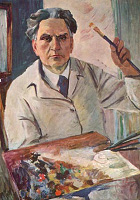ARMENIAN CULTURE: FROM ANCIENT TIMES TO THE 21st CENTURY
“Armenia is the cradle of civilization,
one of the progressive and developed countries of the Ancient World”.
Franz Werfel, Austrian writer and humanist
The origins of Armenian culture date back to the time of the formation of Armenian tribal unions and state institutions. They are familiar to us due to excavation materials as well as preserved myths and religious beliefs. Numerous ancient settlements, Cyclopean fortresses and plentiful tombs (Metsamor, Lchashen, Vanadzor, etc.) were discovered on the territory of historical Armenia. Weapons, tools, household items, figurines and jewelry, that were found thereby, are indicative of ancient and high cultural development. The kingdom of Van (Ararat) (9th-7th centuries BC) played a special role in the formation and development of ancient Armenian culture. After the fall of Urartu, its famous cuneiform writing became a thing of the past. Urartian urban planning and fresco painting were distinguished by remarkable features, which were discovered during the excavations of the fortress cities of Erebuni (Yerevan), Argishtikhinili and Teishebaini. Not only numerous samples of buildings have been preserved, but also clay and metal products, weapons, armor and jewelry. It is worth mentioning the silver goblets (rhytons) with horsemen sculptures excavated in Arinberd (Teishebaini). Today architecture is one of the most fascinating art forms in Armenia, and richly adorned churches are undoubtedly a vivid confirmation of this.
 The Armenians love music and have created exquisite musical masterpieces over the centuries. The Sharakan is the melismatic monophonic chant used in the liturgy of the Armenian Apostolic Church from the Middle Ages. Special musical instruments orchestrate Armenian folk songs. Sayat Nova, Komitas and Aram Khachaturian are among the most prominent Armenian composers. Contemporary music comes in the form of jazz and pop. The Komitas National Conservatory contributes to the musical education of younger generations. The frequent concerts in Yerevan provide delightful evenings at renowned venues such as the Philharmonic, Komitas Chamber Music House and the Yerevan Opera.
The Armenians love music and have created exquisite musical masterpieces over the centuries. The Sharakan is the melismatic monophonic chant used in the liturgy of the Armenian Apostolic Church from the Middle Ages. Special musical instruments orchestrate Armenian folk songs. Sayat Nova, Komitas and Aram Khachaturian are among the most prominent Armenian composers. Contemporary music comes in the form of jazz and pop. The Komitas National Conservatory contributes to the musical education of younger generations. The frequent concerts in Yerevan provide delightful evenings at renowned venues such as the Philharmonic, Komitas Chamber Music House and the Yerevan Opera.

Literature has always played an essential role in the development of Armenian national and cultural identity. Before the creation of the Armenian alphabet in the 5th century, Armenian legends and folk stories had been passed down through speech from one generation to the next or written down in foreign languages. Armenian manuscripts, gorgeously illustrated with miniatures, combine literary traditions and the art of illumination. The invention of the Armenian alphabet by Mesrop Mashtots, that reflects the Christian culture and highlights the richness of the Armenian language, gave a new impetus to the development of unique cultural traditions. This alphabet has not undergone any significant revision to the present day. One can admire Armenian literary and artistic history in the Matenadaran, Institute of Ancient Manuscripts in Yerevan, a unique institution in the world, which houses an extraordinary collection of 14,000 volumes including complete manuscripts, fragments and miniatures. The oldest manuscripts are parchments dating from the 5th and 6th centuries.
The history of Armenian theater dates back more than 2000 years. At Matenadaran there are also a number of manuscripts concerning theater. According to the Greek historian Plutarch, there were performances staged in Artashat in 53 BC, and Armenian King Artavazd was also known for composing tragedies. Theater art is still very popular in Armenia with the majority of theatrical traditions preserved.

It was especially in the 19th century that Armenian painting experienced a remarkable breakthrough. Such painters of this period as the portraitist Hakob Hovnatanyan or the marine landscape artist Ivan Aivazovsky are internationally recognized to the present day. In the 20th century, Martiros Sarian gave to the world a new feel of nature depiction. It is also worth mentioning Arshile Gorky, who influenced a whole generation of young American painters in New York, such as Jean Carzou and Jean Jansem, whose glory arose in France. A visit to the Saryan Park in Yerevan will give you an incredible opportunity to get acquainted with some contemporary Armenian painters.

Armenia is also considered to be one of the oldest centers of carpet-weaving art in the world. In Armenia one can find numerous shops selling old and new carpets. In Yerevan’s flea market (Vernissage) visitors can have a view of counters full of Armenian motifs, including jewelry, precious and semi-precious stones, for example, obsidian, which is widely used in Armenia.
Our country is also known for its khachkars: wooden sculptures that often reproduce the ancient steles engraved with crosses.
Armenia is often called an open-air museum. Tourists can find more than 4000 historical monuments tracing back to different periods of the country's history, from prehistoric to Hellenistic times, from the beginning of the Christian era to the present day.

